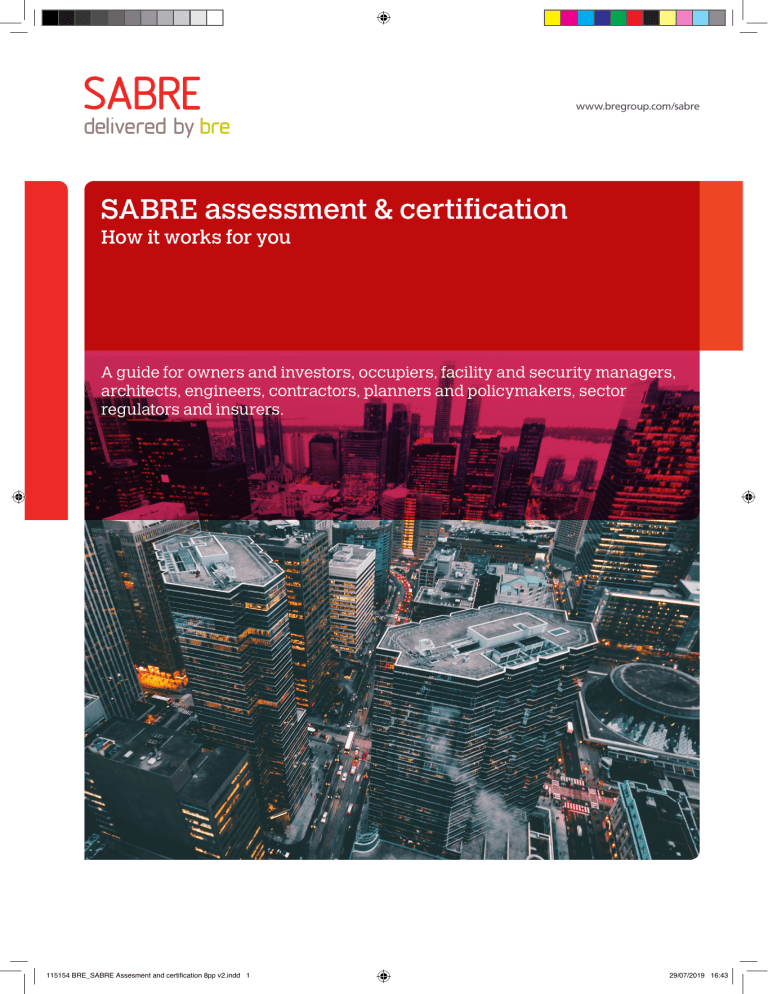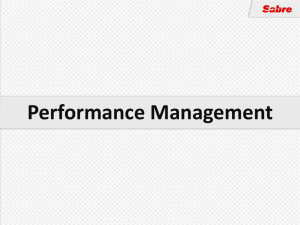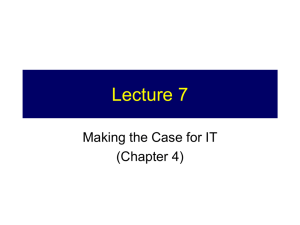
www.bregroup.com/sabre SABRE assessment & certification How it works for you A guide for owners and investors, occupiers, facility and security managers, architects, engineers, contractors, planners and policymakers, sector regulators and insurers. 115154 BRE_SABRE Assesment and certification 8pp v2.indd 1 29/07/2019 16:43 2 3 SABRE allows users to measure, compare and communicate their security risk management performance… Owners & investors Owner occupiers It should be relatively easy to identify who is responsible for security at a facility owned and occupied by the same organisation. These owner occupiers have the freedom to procure and operate security controls that meet their specific requirements. A building which is designed and constructed with security in mind will have a greater potential to resist criminal and terrorist acts. New Facility SABRE certification provides owner occupiers with independent assurance that security was a fundamental consideration during the design and procurement process, and added confidence that their assets are exposed to reduced levels of risk. SABRE (Security Assurance by the Building Research Establishment) – the first of its kind – is a security assessment and certification scheme for buildings and built infrastructure assets, offering users an independently assessed security risk management rating (SABRE Rating). In-Use SABRE certification can be used to measure and compare performance once a facility is occupied and, in doing so, demonstrate effective security risk management that results in exposure to reduced levels of risk. The scheme recognises and rewards good practice in security risk management during built asset planning and design, construction and operations. SABRE certification evidences that those responsible for security have adopted a systematic and risk based approach. Real estate investors SABRE has been developed to help responsible persons deliver appropriate and proportionate security, obtain value for money in their investment decisions, improve transparency and communicate their security credentials to interested parties. A tenancy contract or lease agreement will define the security obligations of the tenant and the building owner. If a tenant is wholly responsible for their organisation’s security and that of the facility during their occupation, the owner or investor may not feel there is an obvious benefit in obtaining SABRE certification, either when procuring a new built asset or for an existing asset. SABRE is owned by BRE Global Ltd (part of the BRE Group), the international provider of robust, independent, third party certification of fire, security and environmental products and services. SABRE is the result of fundamental scientific and market research funded by the BRE Trust. …and provides multiple benefits to a range of stakeholders SABRE can benefit not only the owner and occupier of a certificated facility, but also a range of stakeholders, including those involved in the procurement and operation of facilities, and in the security supply chain. This document provides a summary of the key benefits provided by SABRE certification for each of the stakeholder groups listed below: - Owners & Investors - Occupiers - Facility & Security Managers - Architects, Engineers & Contractors - Planners & Policymakers - Sector Regulators & Insurers 115154 BRE_SABRE Assesment and certification 8pp v2.indd 2-3 However, when seeking tenants to occupy a new building, or at the expiry of an existing tenancy, it may be difficult to attract security conscious organisations to a building that is inherently insecure and that may require a prospective tenant to invest in additional security controls and costly operational solutions. A SABRE Rating demonstrates to prospective tenants that the building owner has given due regard to security, and that risk mitigation has been considered during the design, construction and management of a property. For owners of serviced facilities e.g. co-working space and retail malls; shared security is often a selling point and a reason for an organisation taking up a tenancy as opposed to becoming an owner occupier, where they may be solely responsible for the mitigation of security risks. Where this is the case, it is paramount that a landlord is able to give confidence to their customers that they offer effective security and that their rents offer value for money. A SABRE Rating can help to provide this assurance. Summary Regardless of the type of tenure, it is in the interest of owners and investors to consider the security of their real estate assets and to be able to communicate the security credentials of their properties to the market in an increasingly security conscious world. A SABRE Rating provides independent third party assurance for all facility stakeholders. 29/07/2019 16:43 4 5 Facility & security managers Occupiers Owner occupiers Facilities managers are often tasked with managing the day-to-day security operations of a facility along with the procurement and maintenance of security controls such as CCTV, access control and physical security measures (e.g. doors and fences). However, far too often, this activity is conducted in the absence of leadership for security, defined security objectives and Key Performance Indicators (KPIs). In this case, it is easy to understand who is responsible for security at a facility and the owner occupier has freedom to procure and operate security controls that meet their organisation’s specific requirements. It is widely acknowledged that a building which is designed and constructed with security in mind will have a greater potential to resist criminal and terrorist acts. New Facility SABRE certification provides owner occupiers with independent assurance that security was a fundamental consideration during the design and procurement process, and added confidence that their assets are exposed to reduced levels of risk. This lack of a systematic approach to security can result in poor outcomes, even where there is significant investment in security. It can be almost impossible to demonstrate that an employer’s money was well spent, as the facility manager may be unable to measure the impact of changes, both made and proposed, to the facility and its security. In-Use SABRE certification can be used to measure and compare performance and in doing so, demonstrate effective security risk management that results in exposure to reduced levels of risk. Facilities managers can use the SABRE framework and assessment results to ensure they have an in-depth understanding of facility security requirements, establish a holistic plan for security risk management and evidence successful implementation and management of their plans. Tenants Prospective tenants Regardless of the type of space you are seeking to occupy, e.g. industrial warehousing, commercial office or retail premises; security needs will influence capital investment and an organisation’s operating costs. Using the SABRE Ratings (Acceptable up to Outstanding), it is possible to compare different lettable spaces on the market and determine whether a given space is appropriate for the needs of your organisation. 115154 BRE_SABRE Assesment and certification 8pp v2.indd 4-5 - The ‘value engineering out’ of security controls where the employer cannot see a benefit arising from their inclusion; and - A need to retrofit additional security controls during or post construction. These scenarios can lead to poor security outcomes and represent a significant procurement risk to the employer, as change is inevitably associated with loss of coordination, additional professional fees and project delays. It can also be a risk to the supply chain should a contractual dispute arise. SABRE recognises and rewards project management, design and procurement practices that lead to better security outcomes and overall design quality. SABRE Ratings (Acceptable to Outstanding) along with a requirement to satisfy specific technical criteria within the scheme, can be used for specification purposes. This provides the design team and contractor with a means of evidencing contractual performance. This can be achieved at the end of a project (certification based on the as-built condition), at design stage and at ‘shell and core’ stage (interim certification). SABRE recognises and rewards a security-minded approach to information management and helps reduce breaches of project Confidentiality, Integrity and Availability. The results of SABRE assessment and certification can be used to understand whether a landlord has identified security threats pertinent to you as a prospective tenant organisation and in response, put in place appropriate controls. The detailed results of the SABRE assessment can be used to identify opportunities for improvement and the allocation of appropriate security budgets. - An employer rejecting design proposals late in the design process; Flexibility SABRE is a performance based standard for facility security risk management and focuses on process and outcomes. As such, the scheme does not prescribe any particular approach to security or any specific type of security solution. Architects and specialist security consultants benefit from the freedom to select controls that are effective, whilst meeting the aesthetic and functional requirements of the project brief. Understanding your obligations A tenancy contract or lease agreement will define the security obligations of a tenant and the building owner. If a landlord is offering security benefits to their tenants, it makes sense to look for buildings with SABRE certification, as this provides assurance in the efficacy of the landlord’s approach to security risk management. Existing tenants (In-Use) In the same way that an environmental credential, such as BREEAM, boosts an organisation’s standing, an In-Use SABRE Rating helps to distinguish your organisation from those who do not proactively address security risks. This is important for organisations wishing to demonstrate corporate social responsibility for their workers, visitors and customers. Unfortunately, poor definition of security objectives at the outset of a project can lead to: Architects, engineers & contractors Security specification & performance It can be difficult, particularly in the case of speculative development projects, for an employer to define what ‘secure’ means to them, what security controls they would expect to see and whether they are appropriate for their project. For most projects, the architect, possibly supported by a security consultant and/or M&E consultant, will develop a security design. BREEAM New Construction SABRE certification enables BREEAM applicants to achieve both credits available in section HEA 06. This includes an Innovation credit for adopting industry best practice. The minimum requirements of the SABRE scheme mean that any SABRE Rating (Acceptable to Outstanding) is deemed to satisfy the BREEAM requirements. Therefore, if security is a key consideration for a BREEAM project, SABRE can help to increase the reward and provide separate certification evidencing a building’s security credentials to future owners, occupiers and tenants. Building Information Modelling (BIM) BIM is growing in popularity and is now mandatory for certain publicly procured projects in the United Kingdom. SABRE recognises that BIM offers employers and their suppliers a range of benefits, but the aggregation of data relating to a facility and its protective controls can present significant security risks if this information is not handled and controlled in a secure manner. SABRE includes criteria for secure information management and can be used to provide assurance that your asset’s information is not your weakest link. 29/07/2019 16:43 6 7 Planners & policymakers Annex A: SABRE in planning conditions Consistency, transparency and independence It is important that any conditions and requirements relating to security that are incorporated in planning policy, plans and associated planning approvals can be discharged in a consistent and fair manner, and are consistent with national policy (i.e. the National Planning Policy Framework). Use of planning conditions Local Planning Authorities may seek to apply planning conditions relating to security in new development to key stages in the development control process: SABRE certification is awarded by LPCB – an independent third party – and as such, planners and policymakers can have confidence that a certificated project has been through a robust, transparent and evidence-based assessment process which is consistent with the NPPF’s requirement to seek appropriate, proportionate security measures in new development. A Local Planning Authority may look to specify that certain development types, or developments in certain areas, achieve a specific SABRE Rating. Alternatively, they may decide to condition specific credits within the scheme that are deemed of specific importance to an application. In either scenario, SABRE is a useful tool for planners to ensure that security has been incorporated from the outset of a project and for evidencing that any design proposals have been implemented in the as-built condition. The SABRE ‘star rating’ system is straightforward and removes the need for planning professionals to learn and understand a wide range of specialist and often dynamic security issues. Flexibility & cost SABRE is a performance based standard for facility security risk management and focuses on process and outcomes. As such, the scheme does not prescribe any particular approach to security or any specific type of security solution. As such, a Local Planning Authority can be confident that SABRE will not result in significant cost impacts on applicants or negatively impact project aesthetics and overall design quality. BREEAM New Construction SABRE certification enables BREEAM applicants to achieve both credits available in section HEA 06. This includes an Innovation credit for adopting industry best practice. The minimum requirements of the SABRE scheme mean that any SABRE Rating (Acceptable to Outstanding) is deemed to satisfy the BREEAM requirements. Therefore, if security is a key consideration for a BREEAM project, SABRE can help to increase the reward and provide separate certification evidencing a building’s security credentials to future owners, occupiers and tenants. Planning conditions SABRE may be used in planning conditions by Local Planning Authorities seeking to ensure that applicants have taken a risk-based, security-minded approach to design and construction. Refer to Annex A for examples of how SABRE can be utilised in planning conditions. Outline approval Whilst a SABRE pre-assessment report has no formal status within the certification process, the use of the pre-assessment as an estimating tool can be useful for all parties, and can offer reasonable confidence to Local Planning Authorities that a SABRE Rating is achievable. Reserved matters and detailed approval It is generally possible to provide a Design (Interim) Stage certificate at the detailed application stage as it can be based on commitments written into specifications for design and building tendering. Sector regulators & insurers Assurance A conventional facility security audit will typically involve an auditor verifying the presence (or otherwise) of certain security control measures. Unfortunately, although this process may be relatively simple to complete using a checklist, such an approach does not provide assurance of system performance and results in the blind application of controls simply to ensure compliance. Ultimately, security is a continual process of managing risks rather than a product, and SABRE recognises the importance of security governance and management as much as the deployment of physical and technical controls. A SABRE Rating is a straightforward way of communicating the efficacy of security risk management at a facility and if required, the detailed findings of the SABRE assessment can be referenced to understand, compare and evaluate system vulnerabilities and anticipated incident impacts at a facility. Independence SABRE certification is awarded by LPCB – an independent 3rd party – and as such, Sector Regulators and Insurers can have confidence that a certificated project has been through a robust, transparent and evidence based assessment process. Completion and occupation Final certification, whether ‘shell and core’ or fit-out inclusive, requires the development to be completed. Final certification will only be issued upon completion of all parts of the development. In all cases, a local planning authority will need to bear in mind the requirements of the National Planning Policy Framework (NPPF). Example planning conditions With the above in mind, the following examples illustrate different approaches to applying planning conditions compatible with the structure of SABRE: Example pre-commencement condition “No development shall take place until evidence that the development hereby approved has been registered with the SABRE certification body and a pre-assessment report or Design (Interim) Stage certificate has been submitted indicating that the development can achieve a minimum SABRE Rating of <Insert Rating>.” Example pre-occupation condition “No building shall be occupied until a final certificate has been issued certifying that a minimum SABRE Rating of <Insert Rating> has been achieved for the development hereby approved.” Example combined condition for developments with staged completion and occupation “Evidence that each element of the development hereby approved has been registered with the SABRE certification body, and that a pre assessment report or Design (Interim) Stage certificate has been submitted indicating that the development can achieve a minimum SABRE Rating of <Insert Rating>, shall be presented to the Local Planning Authority within 6 weeks of the date of this decision and a Final certificate confirming minimum SABRE Rating of <Insert Rating> shall be presented to the Local Planning Authority within 6 months of the occupation of the development.” Whatever approach is taken, pre-application discussions at the earliest possible stage coupled with the early engagement of a SABRE Assessor should help to ensure that the assessment and certification process is completed in a timely manner. If you are a planning professional and want to find a SABRE assessor, please visit www.RedBookLive.com 115154 BRE_SABRE Assesment and certification 8pp v2.indd 6-7 29/07/2019 16:43 SABRE Online: security self-assessment for existing facilities Specifically for existing facilities, SABRE online is a security risk management tool that enables companies to self-assess. The tool can be used to review multiple facilities, from a single asset through to an entire international property portfolio. Companies are able to gauge the likely performance of their facilities against the requirements of the SABRE standard, and then compare the performance across their estate. Assessment of each facility results in an indicative SABRE Score and SABRE Rating. The SABRE Scores and Ratings, together with the integral reporting function, help asset owners and managers to: – Effectively manage future investment by identifying potential improvements which can be scheduled and monitored within the tool itself. – Present the self-assessment results to internal and external stakeholders. – Monitor performance over time of both facilities and assessment managers. Asset owners, with the support of a SABRE Registered Assessor, can take their asset(s) through to SABRE certification to gain third party recognition for their commitment to security assurance. www.bregroup.com/sabreonline Watford, UK WD25 9XX +44 (0)333 321 88 11 sabre@bre.co.uk www.bregroup.com/sabre 115154 BRE_SABRE Assesment and certification 8pp v2.indd 8 BRE Group BRE Group is the world’s leading building science centre with a mission to “build a better world together.” BRE Group is owned by the BRE Trust. The BRE Trust is a registered charity in England & Wales: No. 1092193, and Scotland: No. SC039320. 115154 BRE© 0719 SABRE 29/07/2019 16:43





